Convex walls in the interior. Accent wall in the interior
The modern interior of a room for receiving guests must be at least somewhat unique. After all, this is the main room in the house, you can say its face. If the interior of the living room is boring, typical, then what impression do you think your home will make on guests? It's not hard to guess.
Depending on the chosen design composition, the highlight of the living room interior can be:
- any piece of furniture,
- accessory,
- expensive and exquisite lamp,
- or a beautiful accent wall.
It is the accent wall in the interior that we will consider in this article. We will define what such decoration of the vertical surface of a room is, talk about the principles of designing an accent wall, its color scheme, texture and much more.
What is an accent wall and why have one in your living room?
Accent wall is an interesting, usually bright, eye-catching design of a more or less large section of the wall. Often the entire wall is used to decorate an accent element.
The main requirement for such a living room decoration is that it matches the spirit of the room's interior design and stands out against the background of the primary colors that are used to decorate horizontal and vertical surfaces. Why anyway? 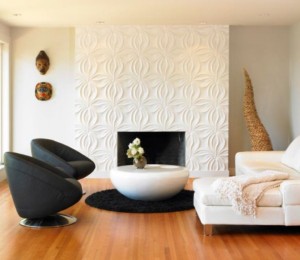 Need an accent wall in your living room? Maybe it’s better to do without it and choose something else as the highlight of the interior?
Need an accent wall in your living room? Maybe it’s better to do without it and choose something else as the highlight of the interior?
- An accent wall allows you to dilute a somewhat monotonous interior with the help of a strictly dosed bright design element of a vertical surface.
- Such a design element will immediately attract the attention of guests and they will have something to do in the first minutes of their visit, looking at the exquisite accent composition on the wall.
- An accent wall can distract the attention of guests from any unsightly element of the interior located nearby and thereby improve the impression of guests from the design composition of the living room.
Principles for decorating an accent wall in a guest room
If you decide to create an accent wall in the guest room, then keep in mind that its proper design is a rather complex task that requires a competent, thoughtful approach. If you take such work lightly, you can make a lot of mistakes and have to redo everything. And this means additional money and labor costs. Not to mention the nerves.
To make your task easier and to form in your head a general understanding of the conceptual aspects of decorating an accent wall and its role in the interior, experienced designers have developed a number of principles for creating this element of living room decoration.
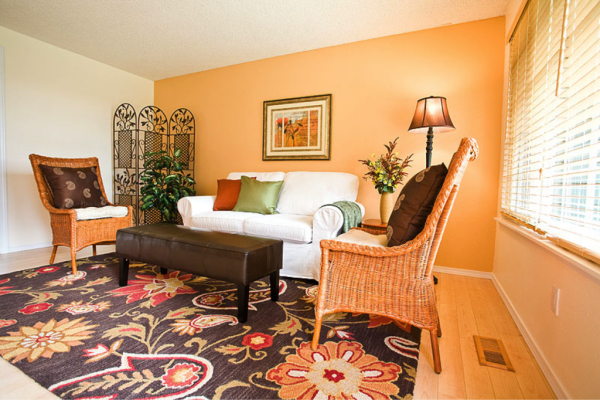
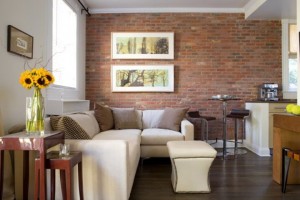
The location of the accent wall in the room for receiving guests - choosing the right one
![]() It is extremely important to position the accent wall correctly in your reception room. This will not only make the interior composition more organic, but will also allow the accent wall to realize all the design functions assigned to it.
It is extremely important to position the accent wall correctly in your reception room. This will not only make the interior composition more organic, but will also allow the accent wall to realize all the design functions assigned to it.
Designers who have extensive experience in creating such interior elements offer some advice on this matter, which we listened to in due time, and we wish the same for you.
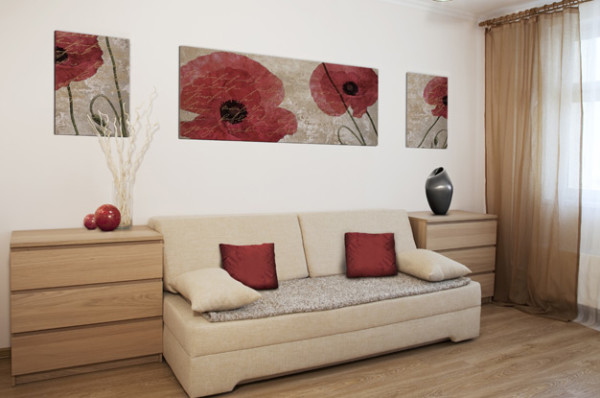
What materials will you need to create an accent wall?
When considering different options for creating an accent wall, you should consider what materials may be required for such a project.
In fact, there is no mystery in the selection of material. The most common materials for wall decoration are suitable, although of course we do not advise you to save money to create a special effect, especially since the vertical surface area to be decorated is very small. So, to create an accent wall you may need the following materials: 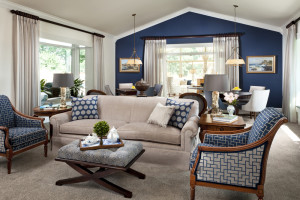
- wallpaper;
- decorative plaster;
- natural or artificial stone;
- tile;
- brick (including its imitation);
- dye;
- tree;
- glass panels and much more.
Accent wall color composition
Many ordinary people naively believe that the most effective way Painting it in bright colors will accentuate the wall. Indeed, in some cases this helps, but for an elegant living room in a modern style, a few bright spots are not always able to emphasize all the splendor and complexity of the design concept, so when 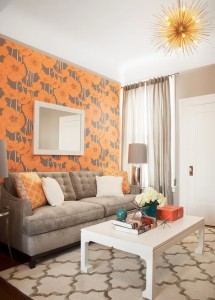 When designing an accent wall, you have to resort to more complex actions.
When designing an accent wall, you have to resort to more complex actions.
In fact, you have to create a mini color composition, which must also organically combine with the color scheme of the entire guest room, which in itself is not easy. When creating a color scheme for an accent wall, there are a few simple rules to remember.
- Warm shades narrow the space, so they should not be used in large quantities in a small living room, but you cannot do without them at all, since a warm color makes the room cozier.
- Cool shades can expand the space, but in large quantities they deprive the room of comfort.
- Pastel shades of any color on their own are not capable of attracting attention, and if you want to use them to decorate an accent wall, add bright spots to them, at least in the form of unusual textured elements.
To summarize, we note that an accent wall in the interior is one of the required elements, without which the design composition looks bland, ordinary and frankly uninteresting. Of course, you can try to replace the accent wall, for example, with beautiful accessories or an exquisite piece of furniture, but achieving a similar design effect will be much more difficult, and most importantly more expensive. Good luck with your interior research!
If you want to surprise all your guests, or just need to diversify the boring decor of the living room, just update one of the walls of the room, but be sure to be bright and unusual. An accent wall in the living room will add freshness, enthusiasm and a new character to the entire interior.
We present to your attention several ways to accent wall decoration in the living room.
Radical coloring
This option does not require much effort on your part and is affordable in every way. However, if you adhere to traditional views in arranging living rooms, it is better to immediately move on to the next point.
This one is dedicated to an unusual coloristic solution, namely, repainting one of the walls in pure black, scarlet, yellow and other catchy tones. We are sure that progressive people who are not afraid of the influence of such colors will be happy to take note of this method, because it can radically change the image of the entire room.
1
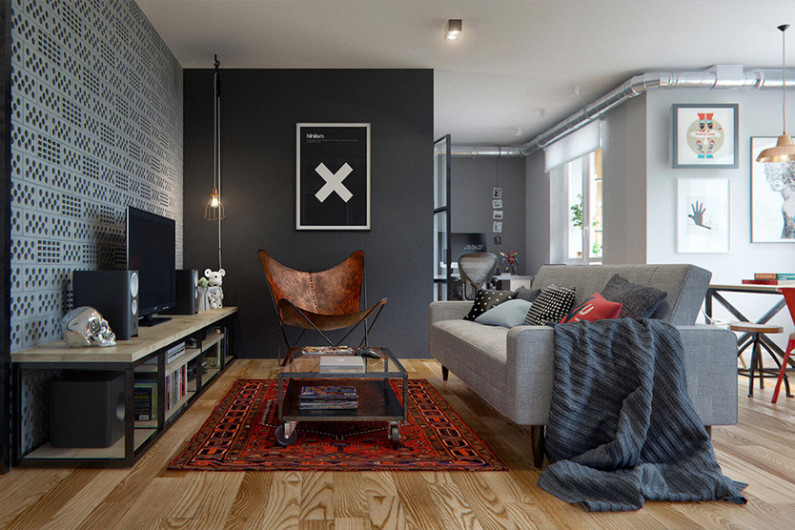
History of the fireplace
If there is a fireplace or its imitation in the living room, it itself becomes the center of attraction of every look. But such an element can serve as the basis for creating an entire accent composition if, for example, the portal is emphasized with beautiful stucco elements (preferably polyurethane, they are not afraid of temperature changes), and the area around it is highlighted with a natural shade of greenery, sea, wooden beams or mirror panels.
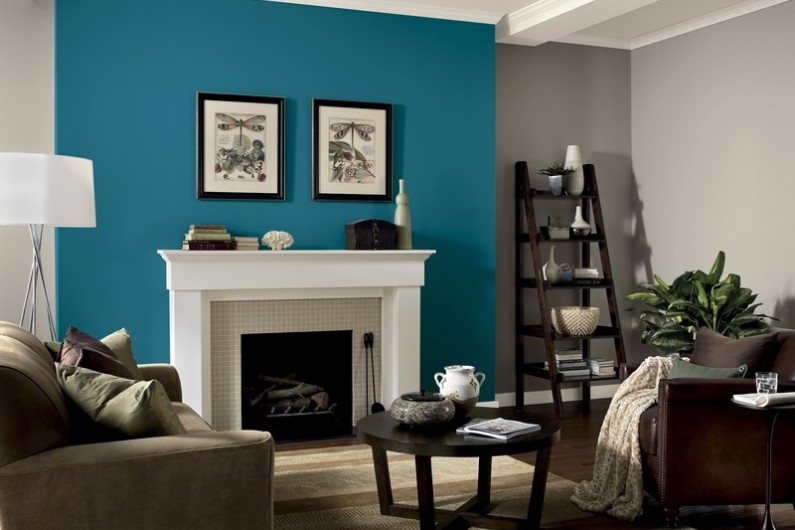 2
2
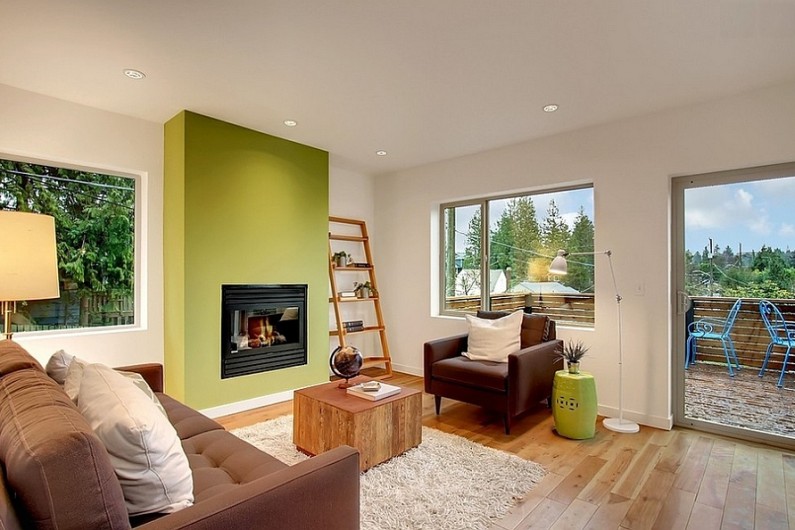 1
1
Brickwork
Usage natural materials in the living room for the purpose of a decorative accent through a beautiful and characteristic texture is doomed to success. Therefore, nothing should stop you from wanting to make the room even more elegant and unique.
Just one wall is enough for its surface, covered with decorative bricks or relief glazed tiles, to become the most prominent area around which the rest of the living room furnishings will be built.
Use lighting - sconces, floor lamps placed nearby, floor lights or a scattering of decorative sources attached to the surface of a brick wall will show its sculpture and volume.
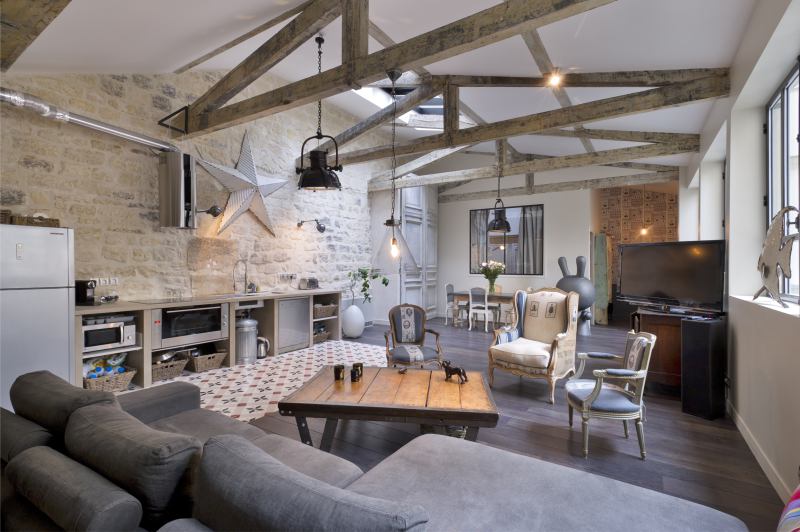
 2
2
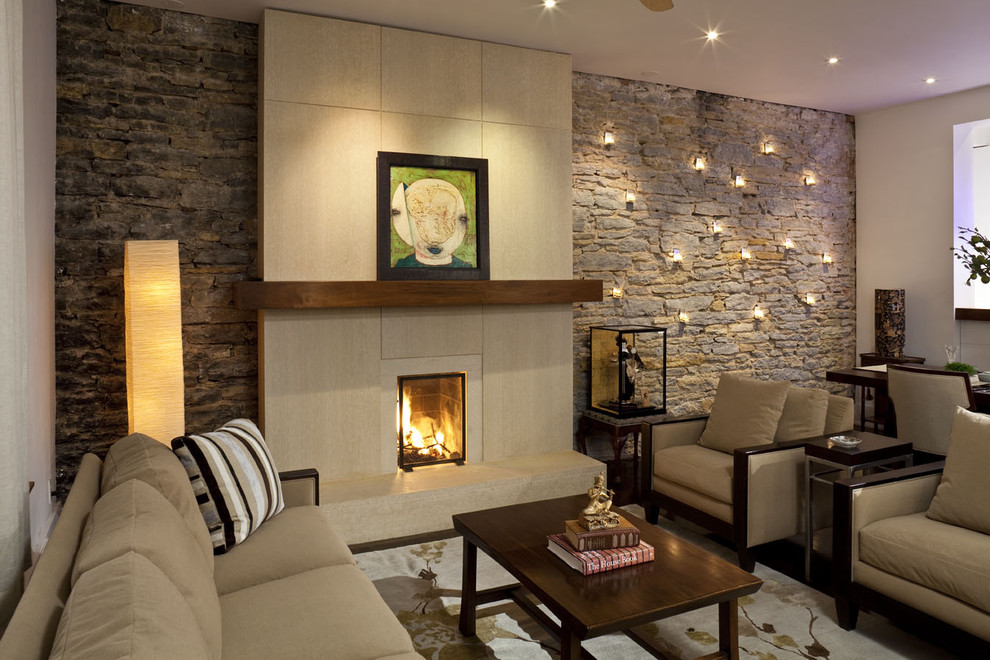
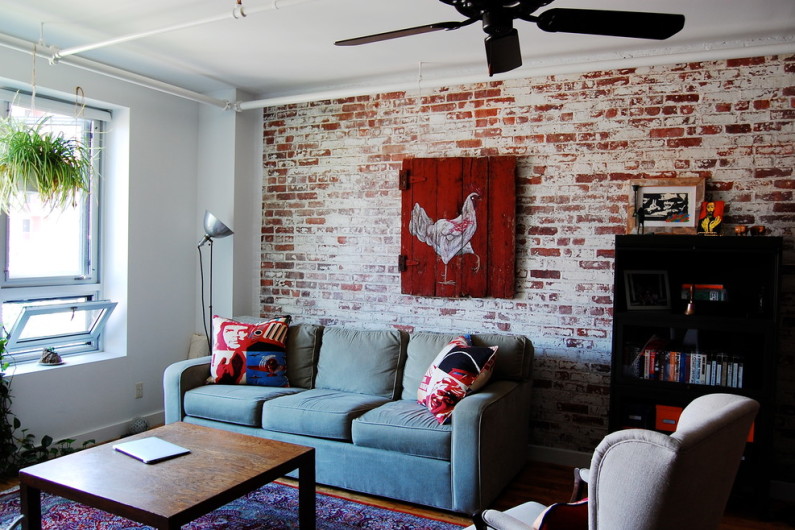 1
1
Very large paintings and mirrors
Mobile items, but quite big size, is effective and convenient when you need to quickly and effortlessly update your living room interior. In addition, the mirror here is already a classic element that is appropriate in any interior style, and the choice of a catchy painting or reproduction can tell a lot about the tastes of the owners.
You should not be afraid that a too large picture will be out of place in a small living room - here it is important to choose a copy that illustrates a perspective image, made in light colors. A simple way to help in the task of expanding a tight space.
![]()
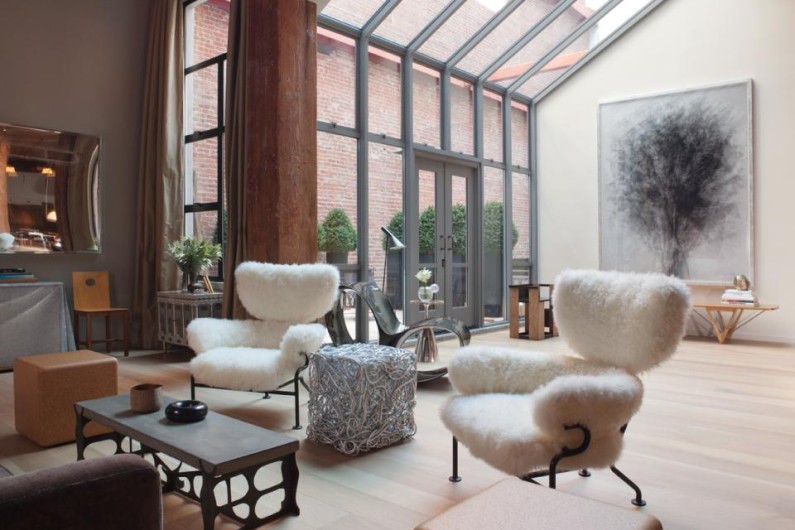 1
1
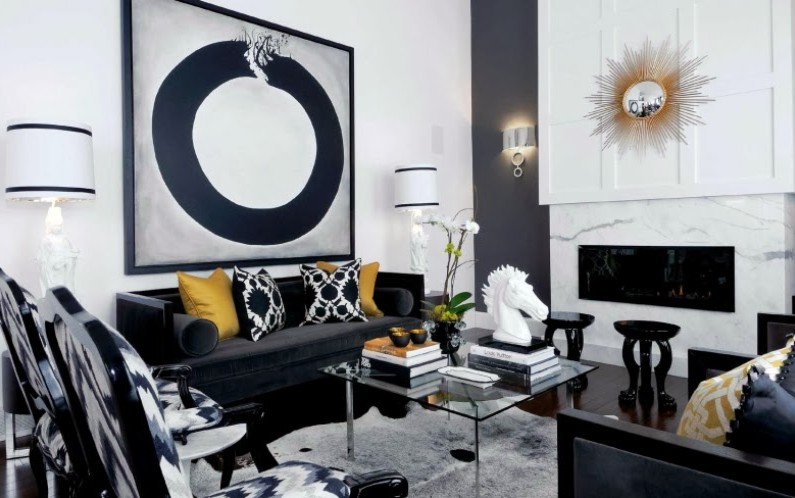 2
2
Unusual solutions for coloring
For those looking for a custom solution for an accent wall in the living room, we recommend paying attention to the current trend of painting the surface using stencils, masking tape and paint in several shades of the same color (or beautiful combinations of different tones).
Zigzags, stripes, waves, ellipses and rhombuses, honeycombs and checkered patterns - you are free to choose any of them, or create a new one by combining different elements.
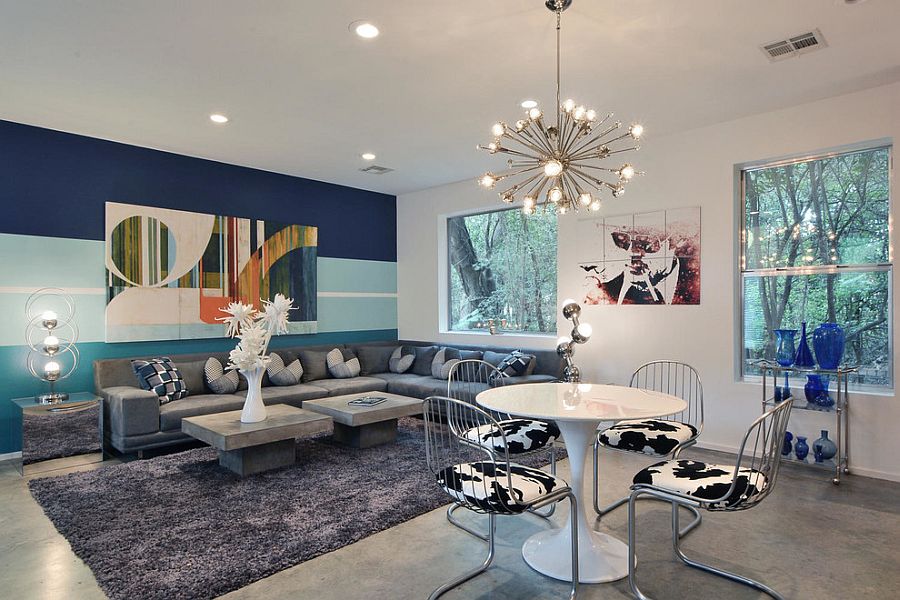 2
2
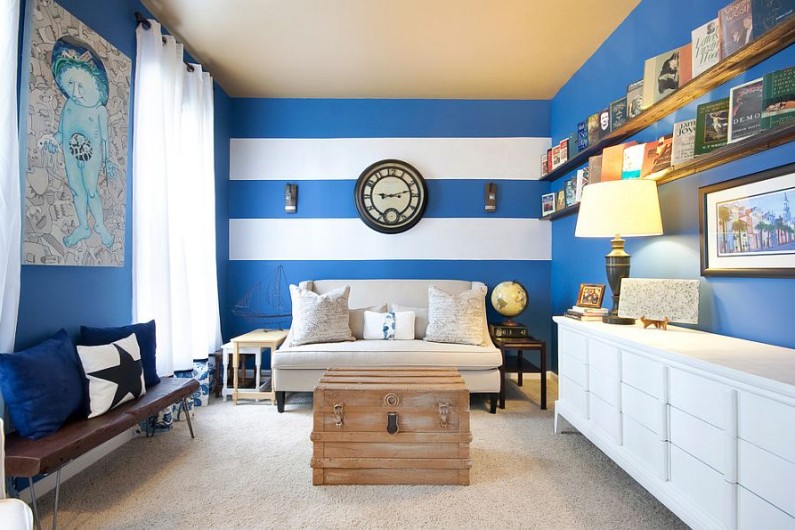
Unexpected decor
When decorating an accent wall in the interior of the living room, try to move away from the usual and understandable methods of decoration. Paintings in carved frames are beautiful, but they are unlikely to surprise anyone. Try to get creative and use items that are innovative, or not intended to be hung on the wall at all.
Of course, the selected items should be adapted to the style of your interior, unless it is fusion or eclecticism, prepare them, stylize them, and perhaps redo them a little. You can, for example, choose an object of an unusual shape, but paint it in a tone that matches the main colors of the room.
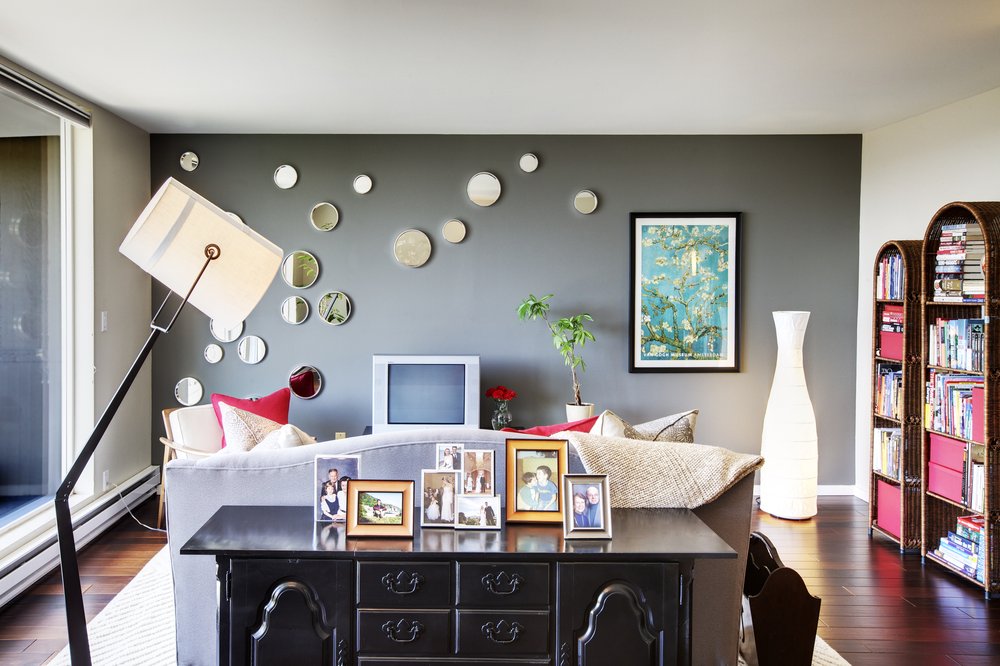 1
1
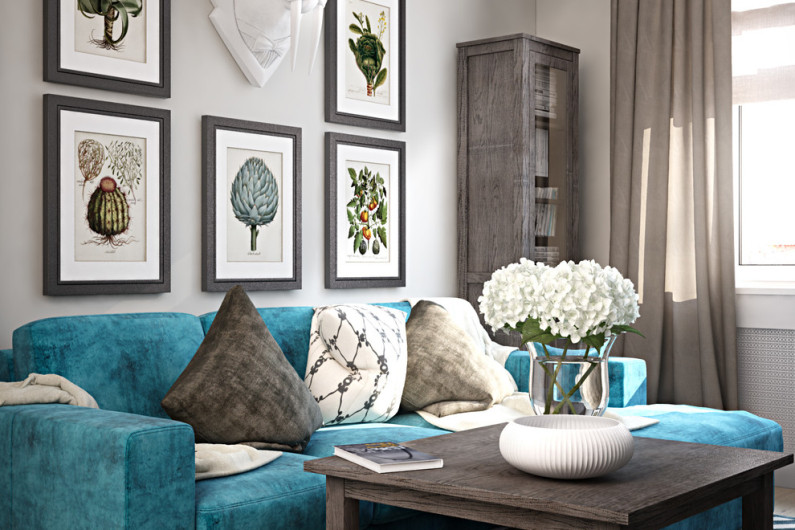 3
3
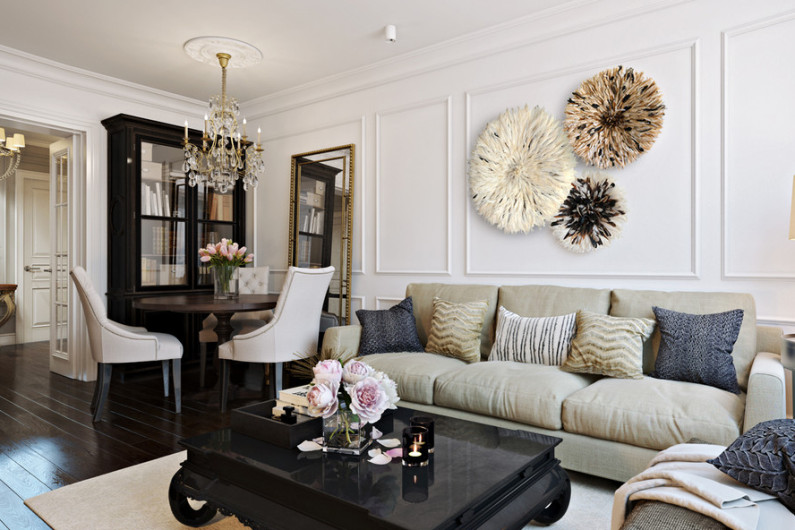 2
2
Functional wall
Finally, you can not only decorate the wall in the living room in an interesting way, but also make it usable (which is especially important for small rooms or studio apartments).
Order a full-wall shelving unit from a carpentry or furniture shop, design a built-in structure with niches and overhangs, or simply hang a few shelves with shaped supports. Now here you can store books, put paintings, decor, vases with flowers, and most importantly, you are free to change, remove or add all this as desired and possible, introducing new shapes and colors into the interior of the living room.
An accent wall is a rather complex decorative technique that is not appropriate in every interior. Why? When one wall is overloaded with color, the integrity of the room is disrupted; not the entire volume of the room is perceived, but the plane.
Today we decided to understand the basic rules for creating accent walls in the interior.
When it's hard to screw everything up: win-win options
In a small room of up to 10 m², such as a bedroom, an accent wall can be placed behind the head of the bed. Highlight it with interesting wallpaper and wall panels.
If the room is large and the wall area is also large enough, then to focus attention you need to use other techniques and materials. The designer’s task is to create a picture, an interior composition that is easy to read at first glance.
Moreover, if it is intended to visually highlight some walls, then this must be provided for already. For example, plan wide doors along the axis of the intended composition so that the viewer sees the picture from a given angle.
Ways to highlight a wall
There are several ways to highlight an accent wall in the interior.
- Using a different material. A rather complicated method due to the compatibility features.
- With the help of a large-scale object and a certain interior composition.
- Through combinations of furniture and paintings. The result is a memorable picture, viewed from a certain vantage point.

Accent wall design options
Using the difference in materials, as well as furniture groups and decorative items, you can place accents and create decent interior compositions. Let's look at how you can highlight a wall correctly.
Wood panels and bookshelves
In a room decorated with wallpaper, one wall can be covered with wood panels. The transition from calm materials to wood looks more appropriate if you place shelves with books on this wall. A library is a traditional and acceptable solution, even though it breaks up the integrity of the room. By the way, there can be two such walls.
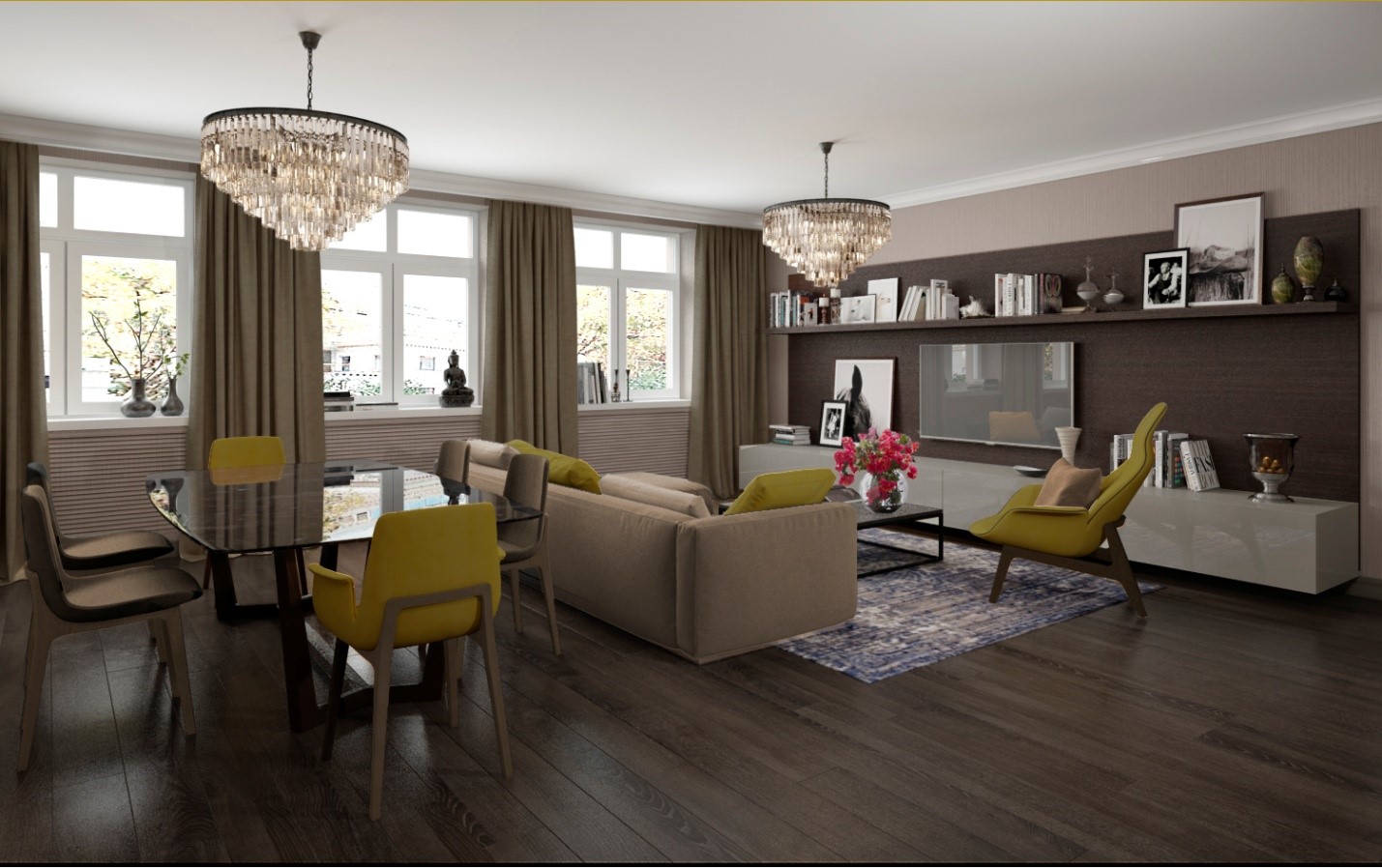
Furniture groups against the background of the library
To support the library, you can build furniture compositions against its background. This technique helps create a more complete interior. Certain furniture groups are suitable for this:
- Armchair composition - a high tea table and 2-3 armchairs.
- A combination of two large armchairs and a low table.
- Sofa composition.
About the sofas. If you want to install it opposite bookshelves, then choose a low model (no more than ¼ of the wall height). Or one or two very light sofas on high legs with a narrow seat and back.
By highlighting this wall with the help of furniture groups, the picture can be complemented with lamps located symmetrically in the corners.
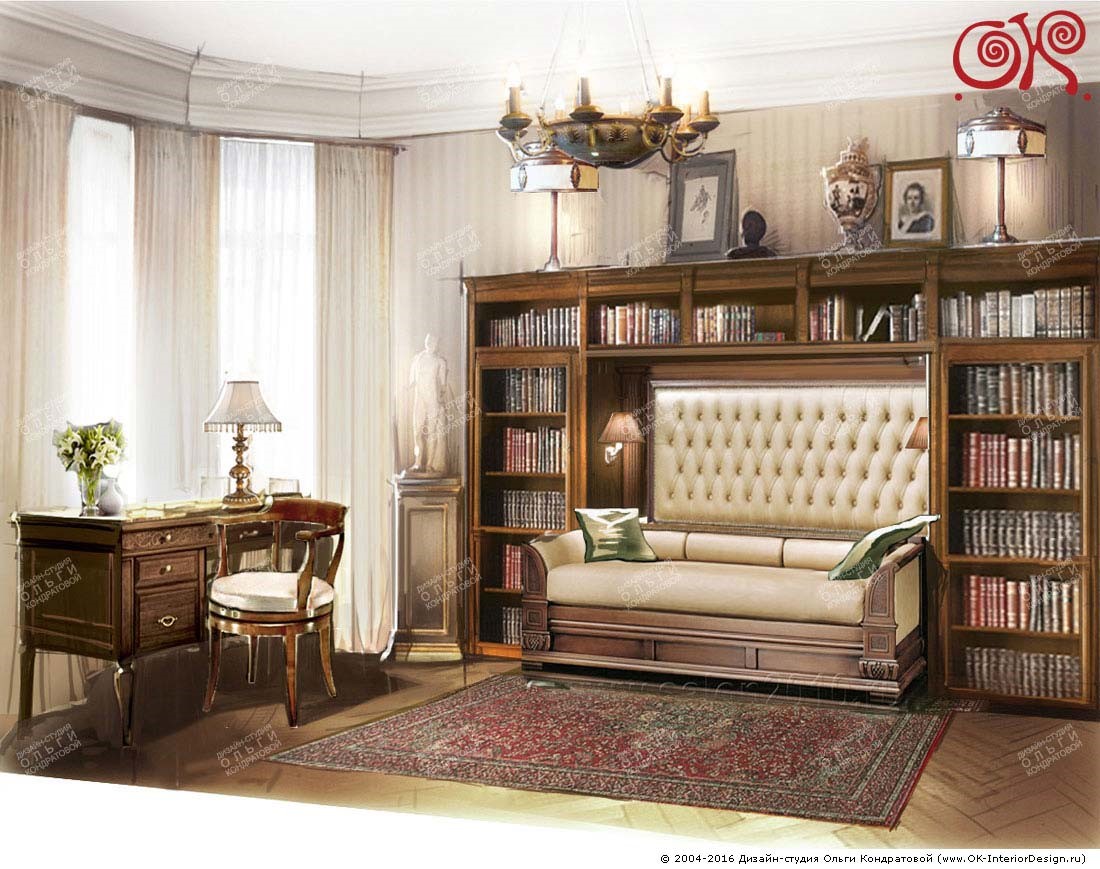
Low cabinets, lamps, paintings
By focusing on the wall with books, you don’t need to fill it with shelves and cabinets from top to bottom. There is a good division of the wall into ⅓ and ⅔.
For example, they select a large niche or opening on the wall and fill it ⅓ with low bookcases, massive wooden chests of drawers, sideboards, and shelves. On top there are paintings and two lamps. In a classic interior you can hang a large picture. If the room is decorated in a modern style, the canvases are placed on the chest of drawers - there may be several of them, different in style. It is also good to highlight a niche with wooden panels.
Such an accent wall should not be blocked by tall or massive objects. Against its background, a desk with an armchair or a dining group looks great. If a dining area is being developed against the backdrop of the library, a tea set is placed on the chest of drawers.
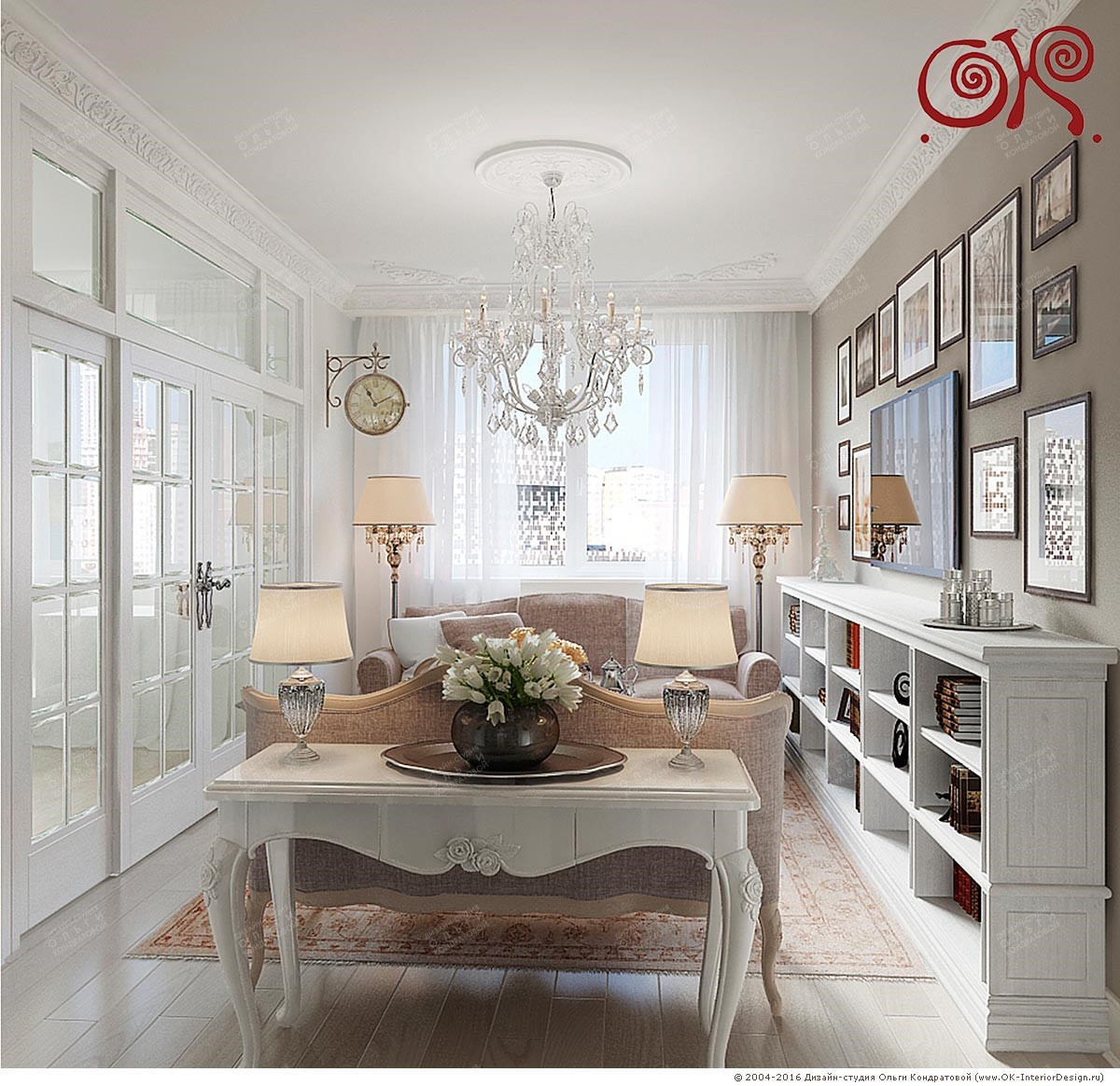
Well-chosen materials
When combining different materials, you need to ensure that they match each other.
If you decide to use wooden panels against the background of wallpaper, then it is better that they are separated by an opening, a niche, and form an alcove. In a painted room, part of the wall can be covered with wallpaper or covered with the same wood.
The wall in the new material should not remain bare - any active material requires that it be “diluted”. These can be paintings, engravings in massive wooden frames. Low furniture looks good against the wall - round and rectangular tables, armchairs, a desk, a bed.
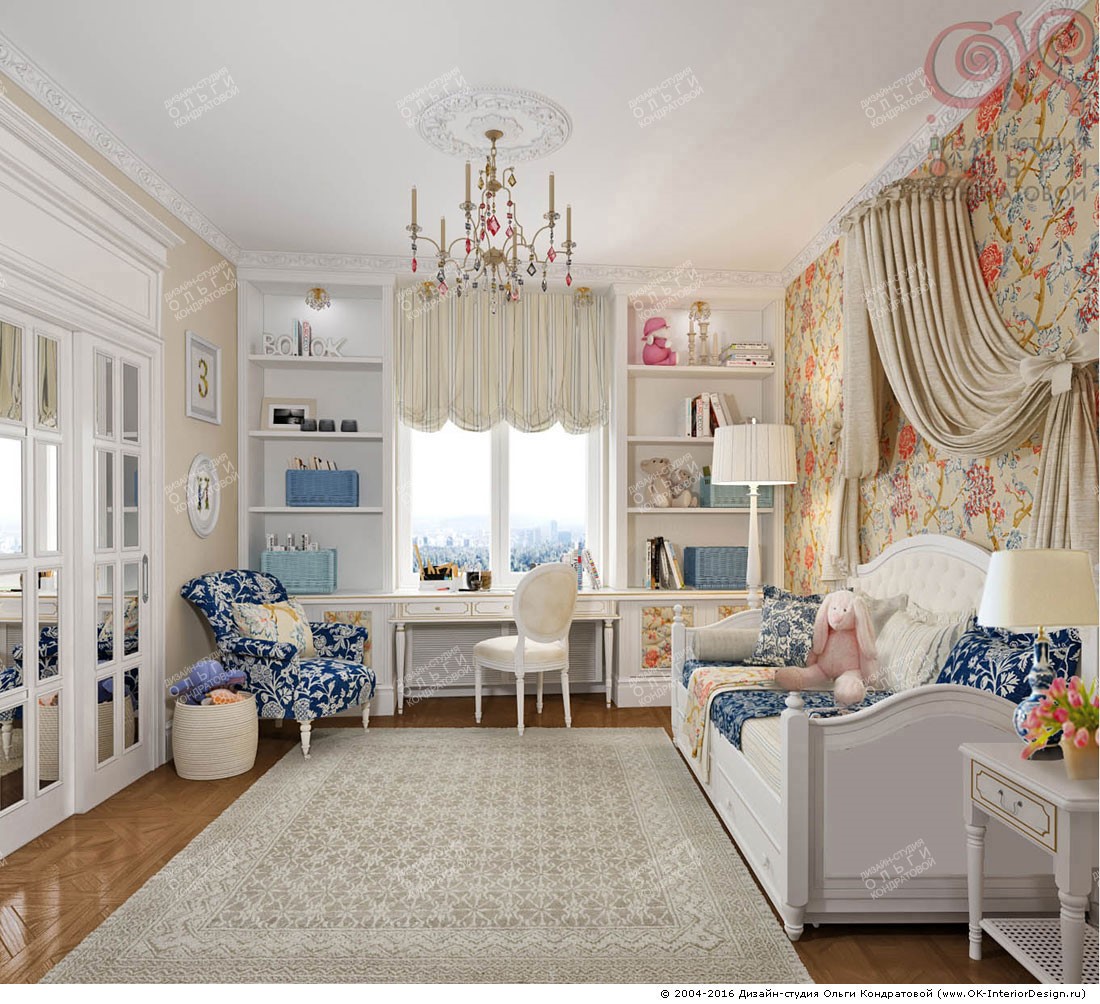
Alcove
In the bedroom, you can separate part of the wall and create an alcove. It is distinguished using a niche or opening. This composition is perceived as a separate room. A bed is placed in the alcove - with the headboard against the accent wall or the side - it doesn’t matter. The composition can be complemented with small side tables or dressing tables.
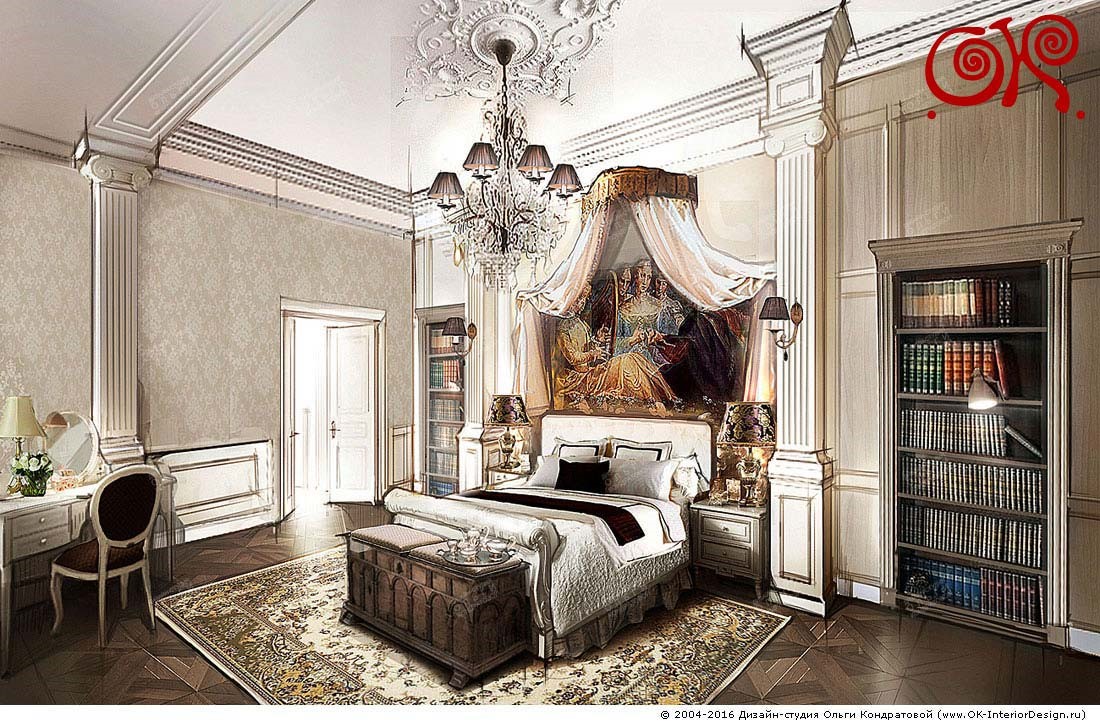
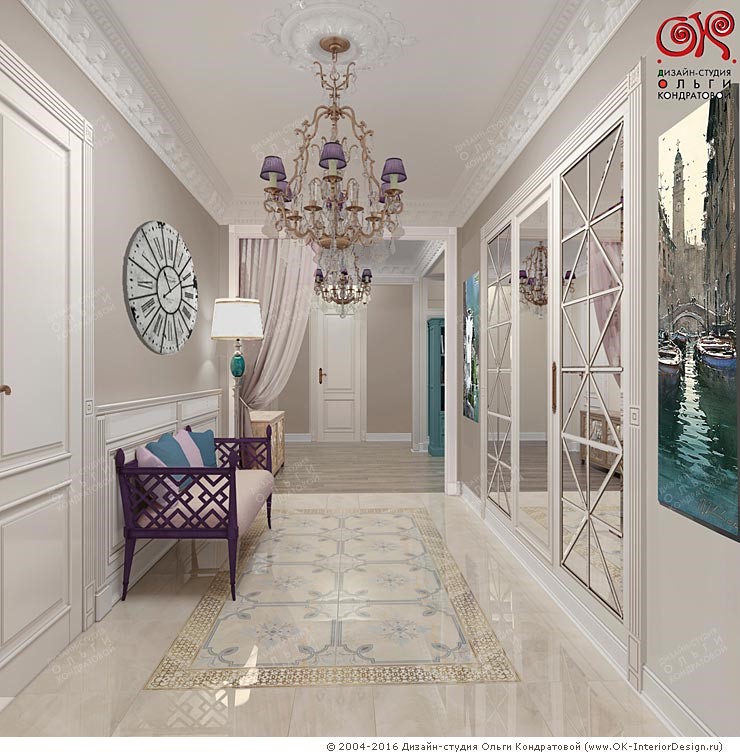
Inner window
An accent wall can be highlighted with an internal window. A wooden window painted in a dark color or made of dark wood copes better with this task. Even with a small amount of furniture, the interior window itself is a good focal point.
In the interior of the hallway, if the entrance axis does not face the window, an accent wall is created opposite the door or highlighted with furniture. In a niche you can place a table with a sculpture or a classic composition of a table with a lamp and two chairs.
There are many ways to highlight a wall in the interior. The main thing here is a sense of proportion and an understanding of how this technique works.
Striving to create better living conditions and take care of your home is a noble endeavor. People are transformed and even begin to think differently when they find themselves in a beautiful, warm, harmoniously decorated room. We have written a lot about bedrooms, choosing a style and color for them, or about effective interior decoration, but as you know, this topic cannot be exhausted.
Today we will talk about how to use the design of one wall in the bedroom to create a stylish, spectacular or simply unusual accent to the entire interior.
Options for accent wall decoration
As a rule, the role of the “first violin” in the bedroom interior is assigned to the wall to which the bed is pressed with the headboard. However, you can choose any of the walls for decoration, for example, the one opposite the bed, the side wall, the wall with a window or doorway. But we’ll tell you point by point about the simplest and most effective ways to decorate a surface and focus attention on it.
Blooming canvas
Again we are talking about the wall behind the head of the sleeping bed, because this area forms a single whole with the bed, side tables or tables, lamps and the headboard itself. It makes perfect sense to make this particular wall an accent wall, and the easiest way is to use brightly patterned wallpaper. It will take a little time to paste one wall, but the positive effect will be obvious.
It is recommended to choose wallpaper with a natural background color and a colorful floral pattern (flowers can be graphic or consist of geometric shapes) - a universal option for a large number of interior styles.
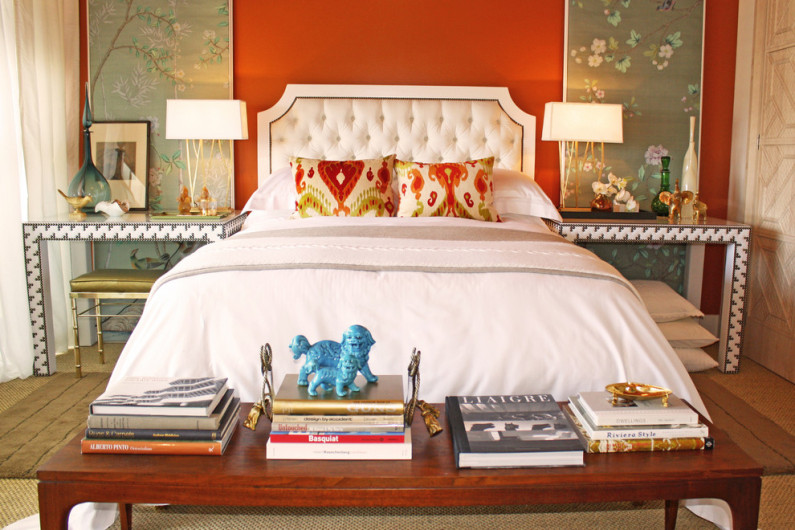
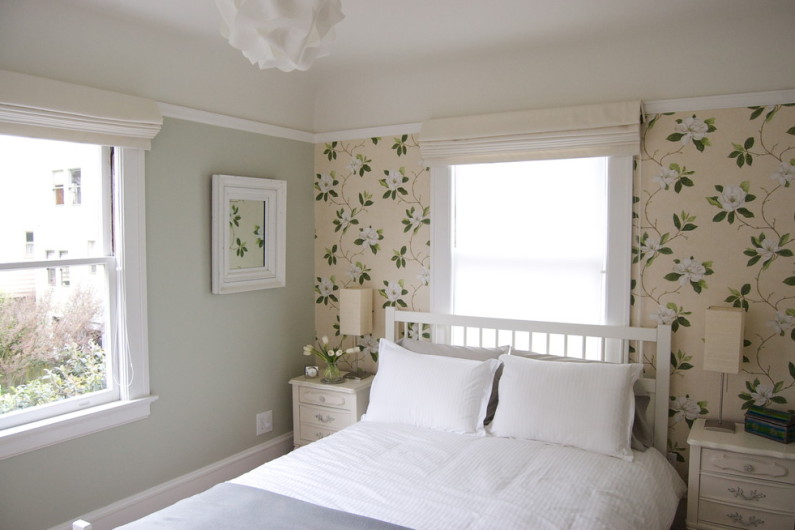 2
2
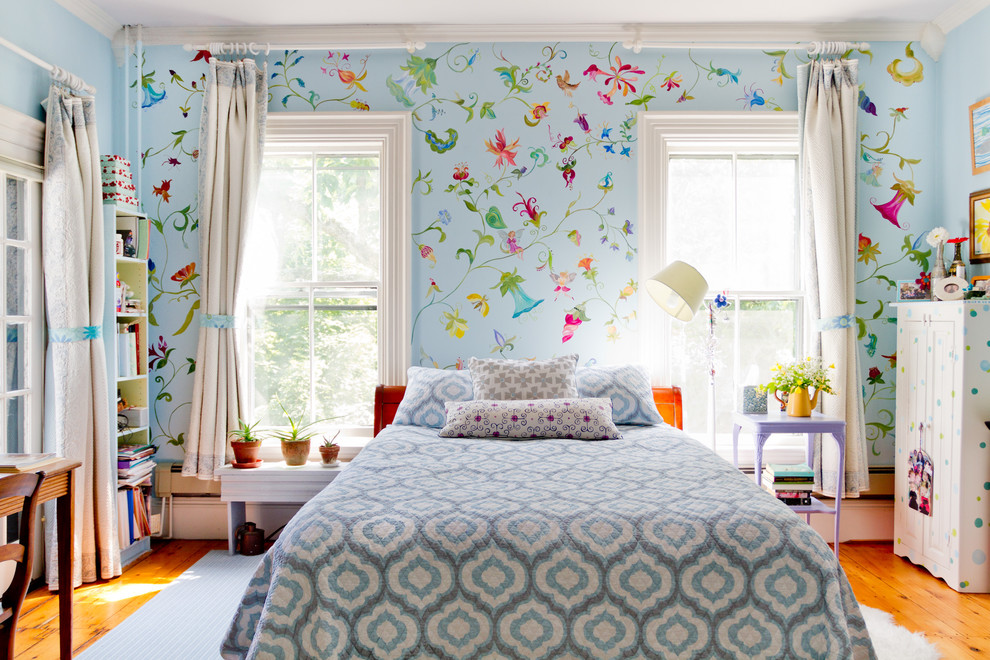 3
3
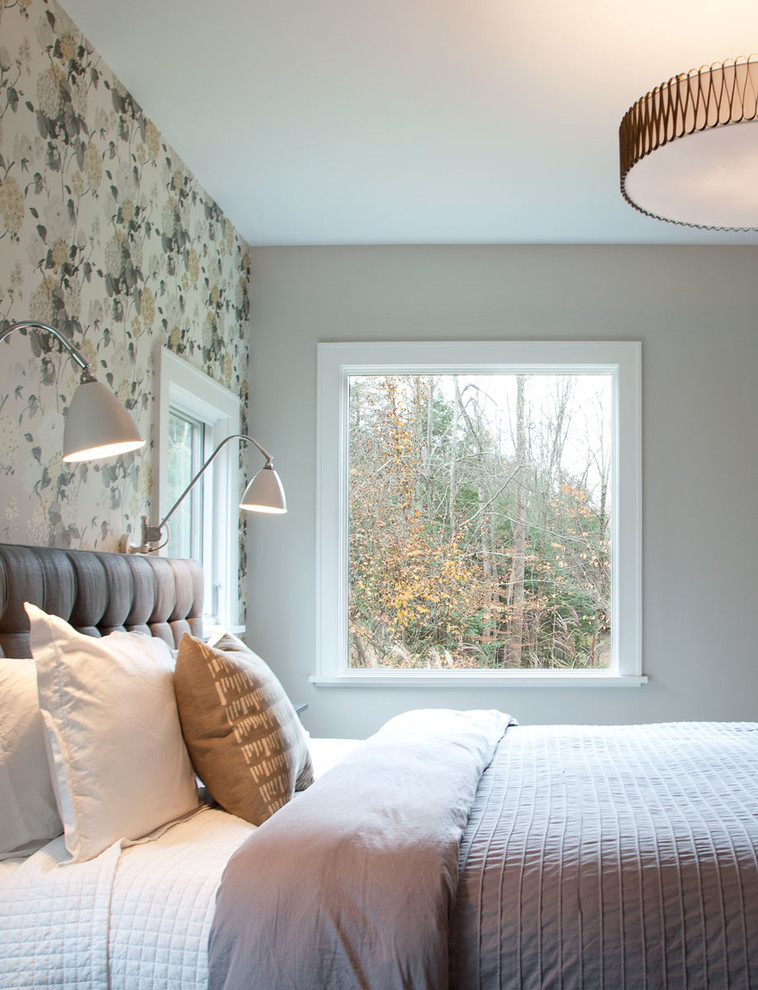 2
2
Background for painting and decoration
The selected wall can be painted in a pure contrasting color, but it should only be natural (grass, cobalt, coral, honey) or neutral (white, gray, black), and the paint should be matte.
Once the surface is prepared, choosing decor will not be difficult: paintings in frames or on stretchers, posters, panels, busts and bas-reliefs, as well as simply beautiful figured frames and mirrors.
The shades predominant in decorative items should cooperate with the background color of the wall and the tones used in the interior. If you spend a little more time selecting them, the result will be pleasantly surprising.
![]()
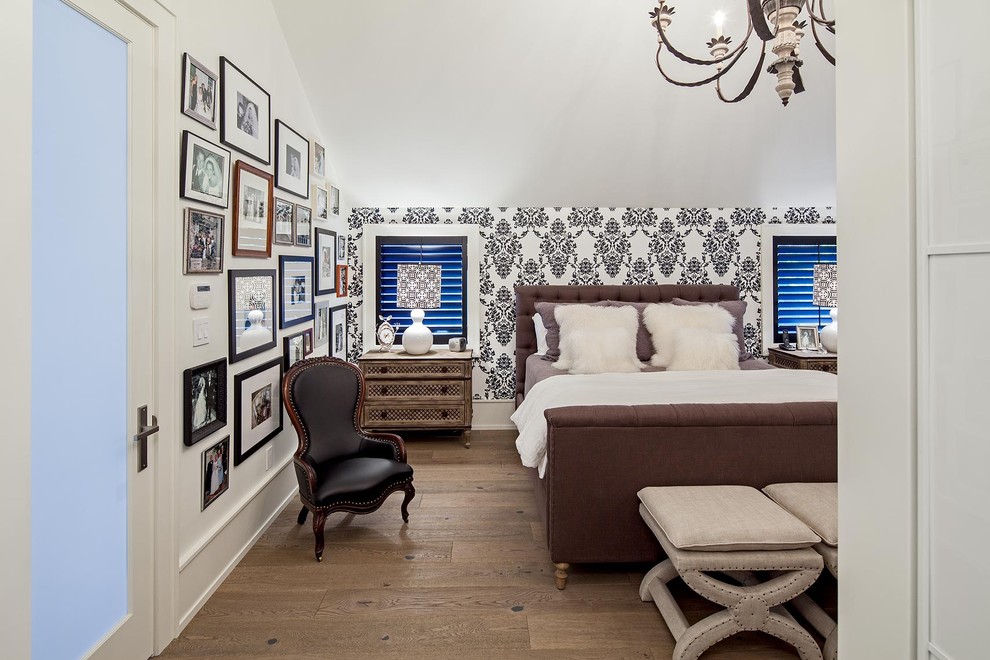 2
2
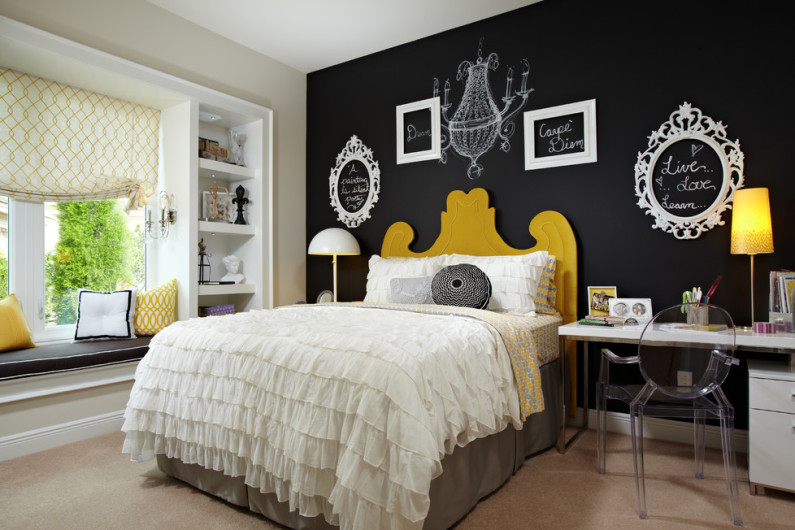 6
6
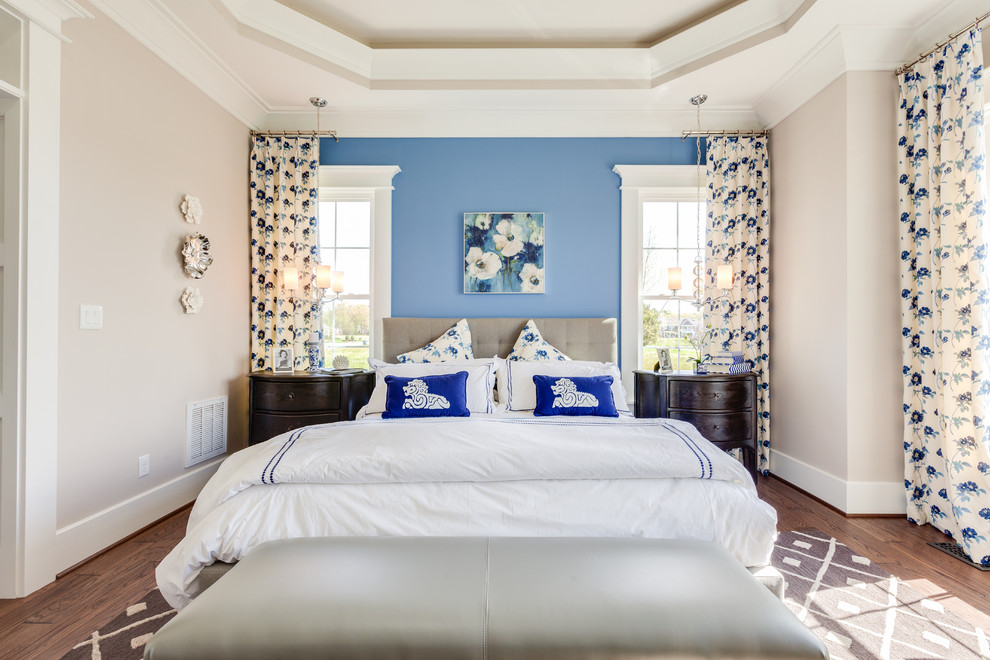 1
1
Attention to the headboard
The headboard itself can make an accent wall if it is very high, figured, decorated with a carriage screed, capitonnes, enclosed in a carved frame, or upholstered in expensive fabric, leather or even fur.
Even the most beautiful headboard, if it is not practical, loses much of its charm, therefore, it is worth thinking carefully before using an overly intricate shape, relief carvings or a material that cannot be washed or wiped frequently. As an option, you can use a mobile structure (decorative screen, panels) or a removable cover with fastenings to the base of the head of the bed.
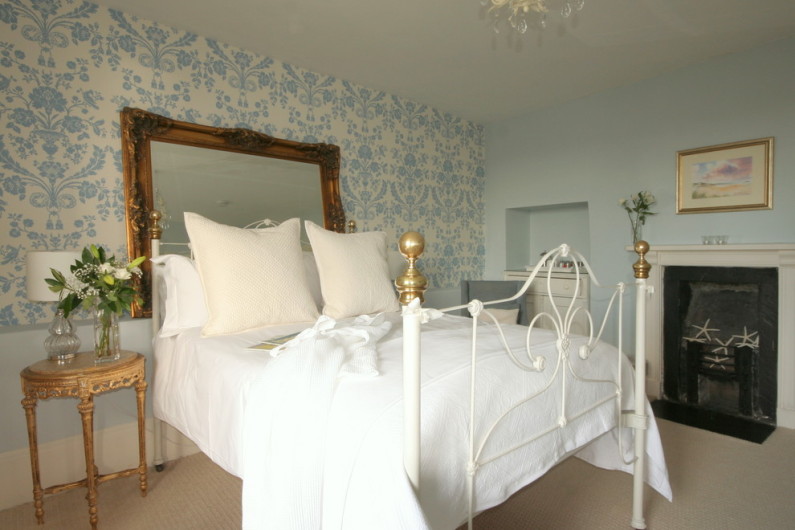
 2
2
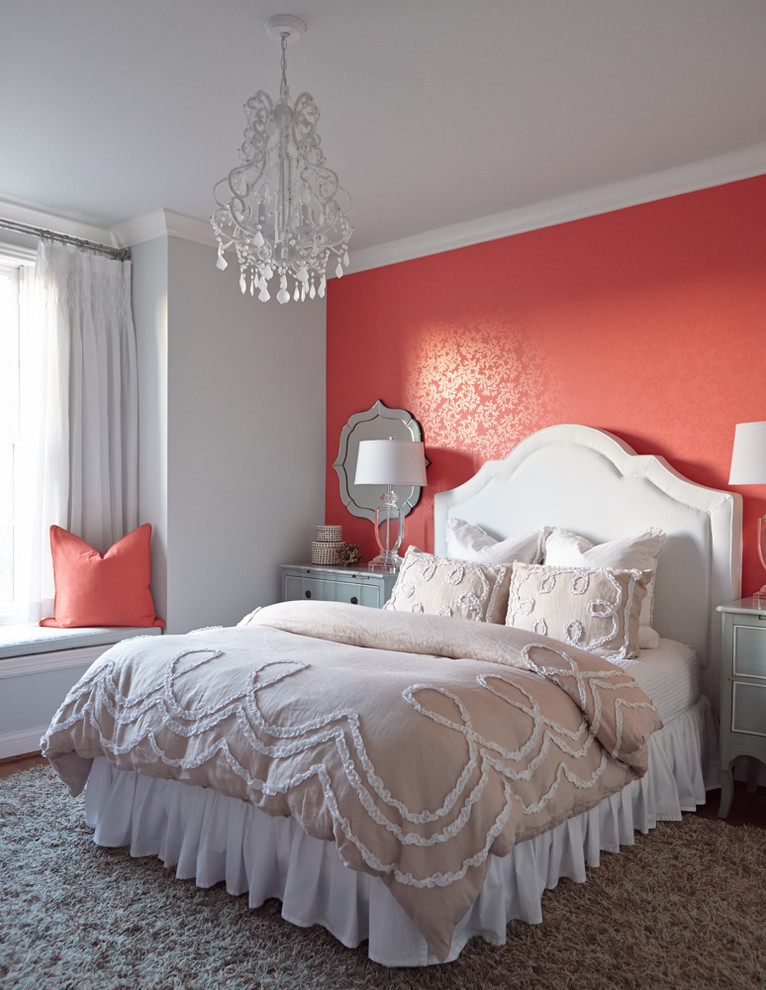 3
3
Graphic variations in tone
It happens that the bedroom interior is made well, the color scheme is chosen correctly and, in general, the decor looks harmonious and complete, but something is missing. Perhaps the room is too homogeneous, and the atmosphere clearly feels the need to somehow enliven and diversify it.
We suggest using graphic designs and motifs in the context of the bedroom color scheme. The wall can be highlighted with the help of unobtrusive squares, circles, geometric patterns, as well as reproductions of engravings or fragments of painting using shades that match the basic tones of the room.
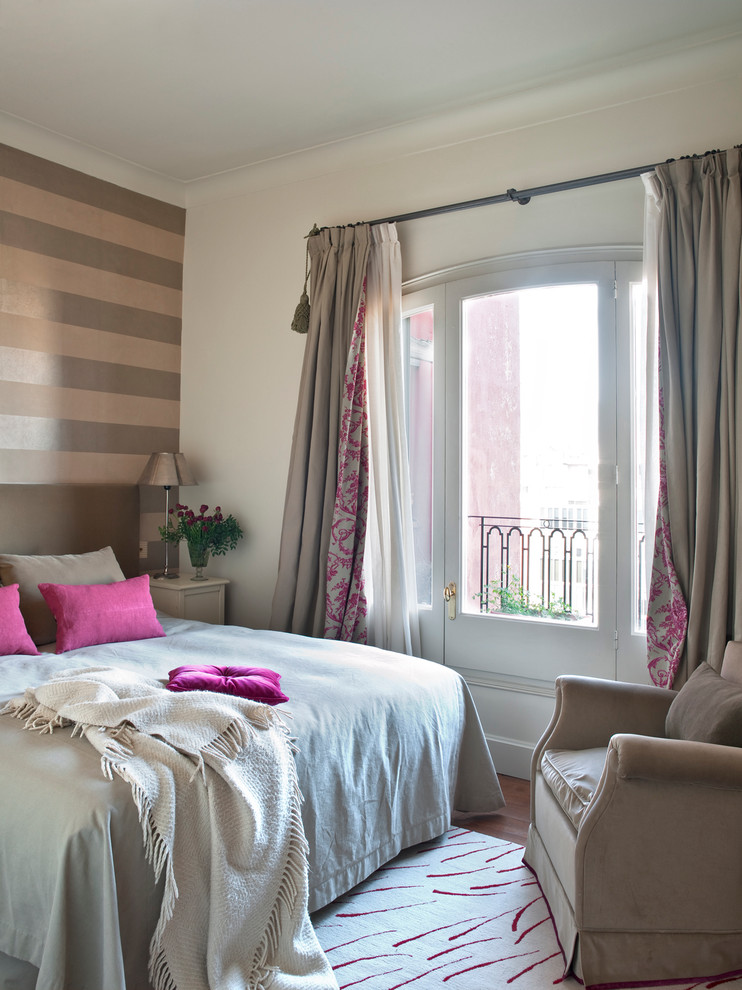 9
9
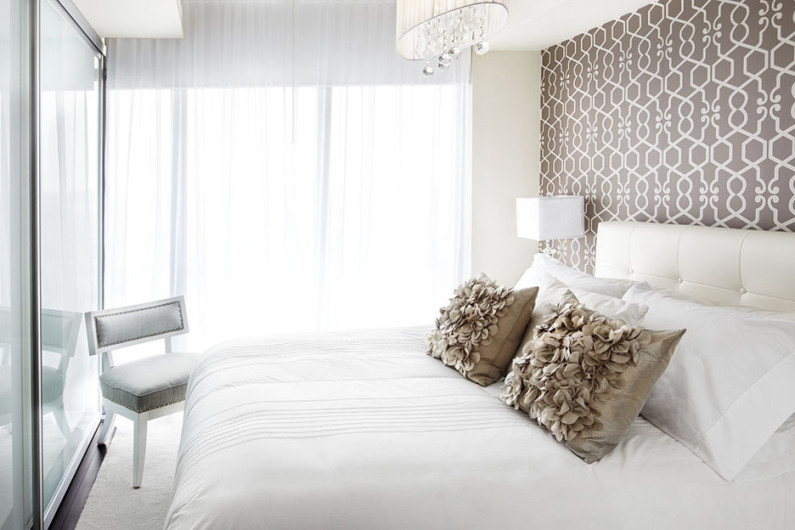 2
2
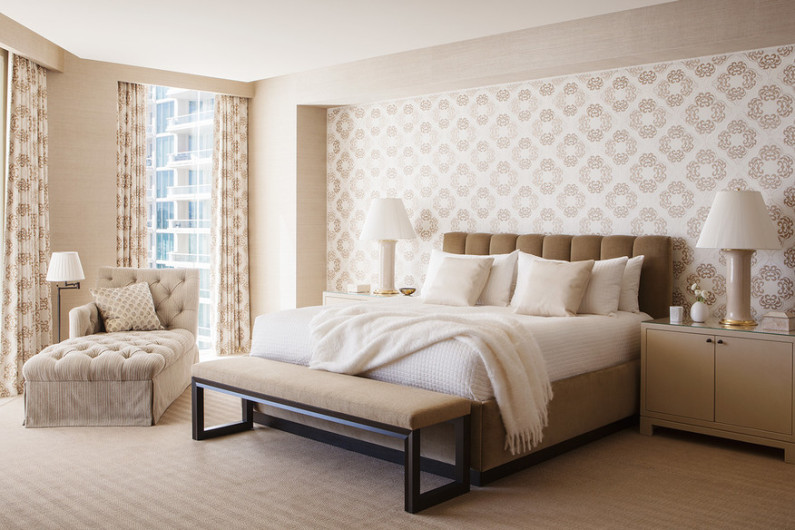 3
3
 3
3
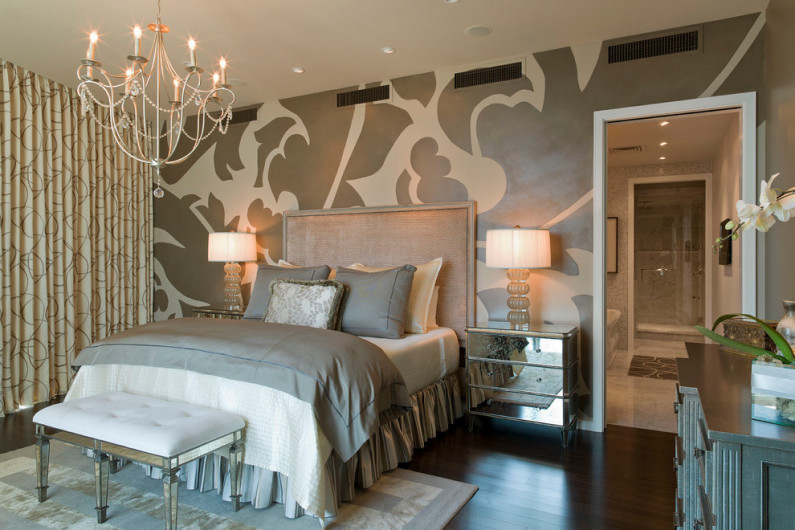 1
1
Sculptural light
A variety of lighting fixtures will definitely help draw attention to a particular wall, and the more unusual the shape chosen for them, the more original the entire surface of the accent wall looks. The main thing is to use more than two lamps near one of the walls, for example, together with wall sconces at the top of the wall, place a couple of table lamps or floor lamps below eye level. You can use directional light and turn the lampshades in the desired direction if necessary - this will disperse the flow of light more evenly and create a light, cozy atmosphere.
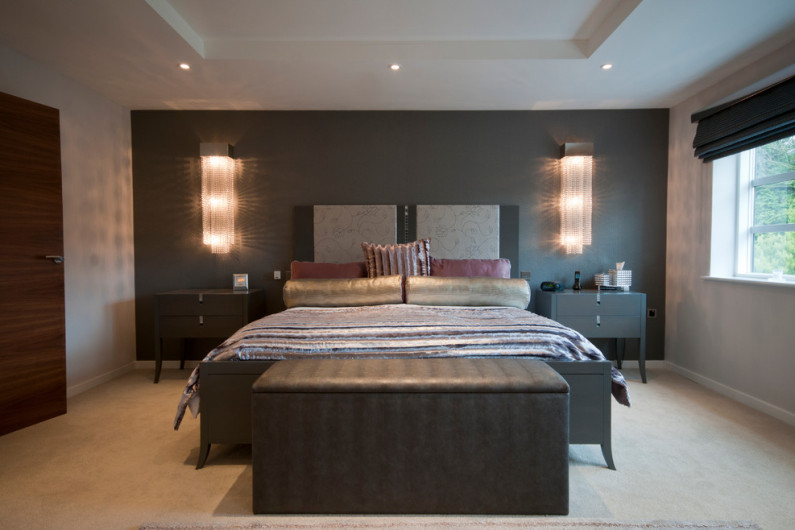 4
4
![]() 2
2
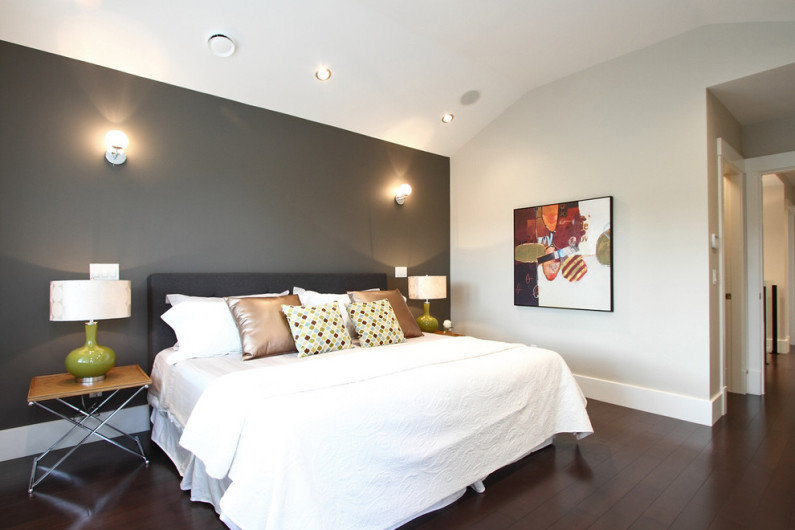
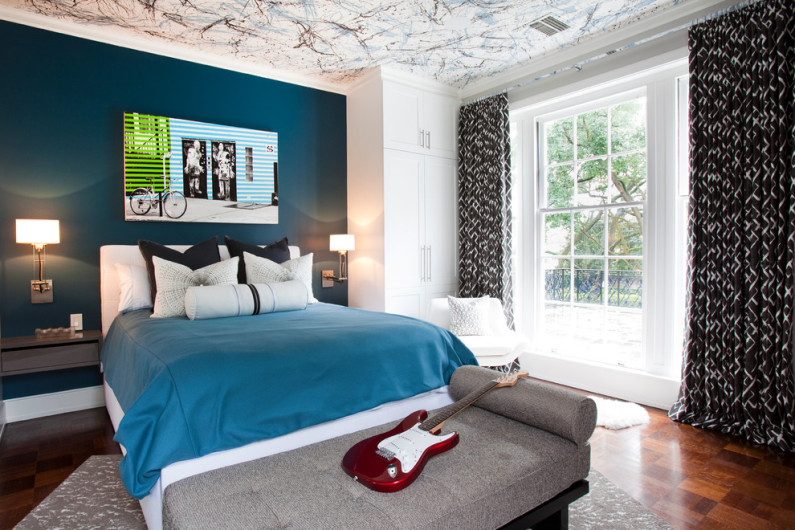 2
2
Rich texture
This method of accenting a wall is more expensive and time consuming as it requires time, investment and creativity. We are talking about decorating the surface using facing materials such as wooden boards (parquet boards, beams, modular panels), ceramic tiles, decorative bricks, and upholstery with natural fabric.
Choice natural materials is not accidental, because in the bedroom interior on the wall they look original and well-made, and the soft natural palette of shades of gray, caramel, wood, sand, brown soothes and gives a feeling of security and closeness to nature.
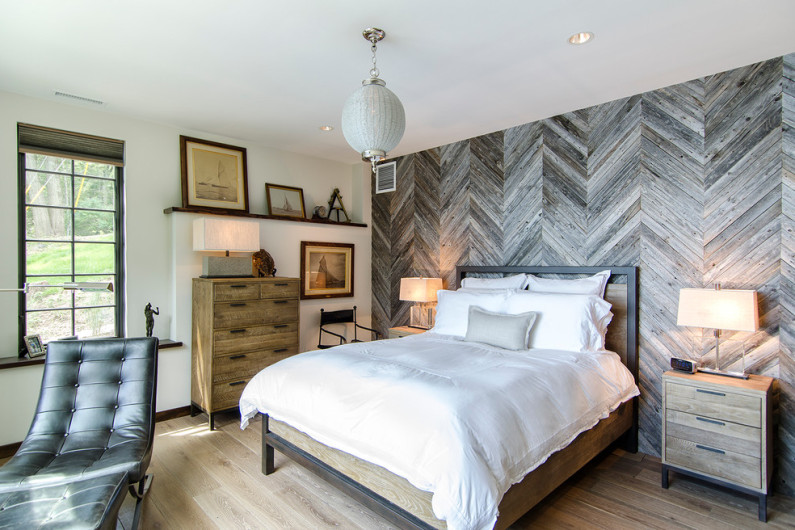 5
5
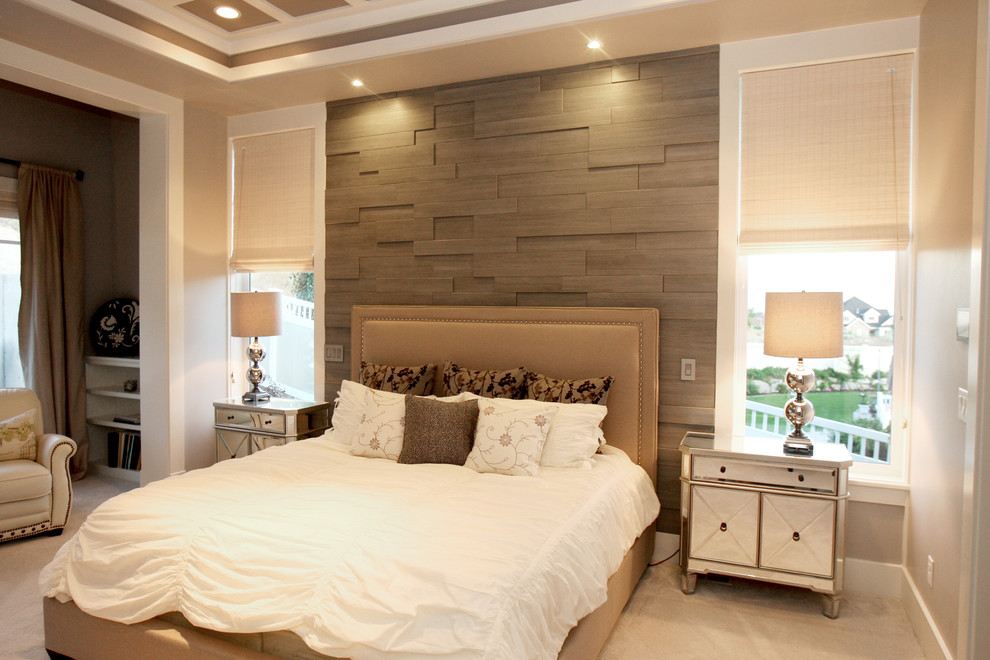 4
4
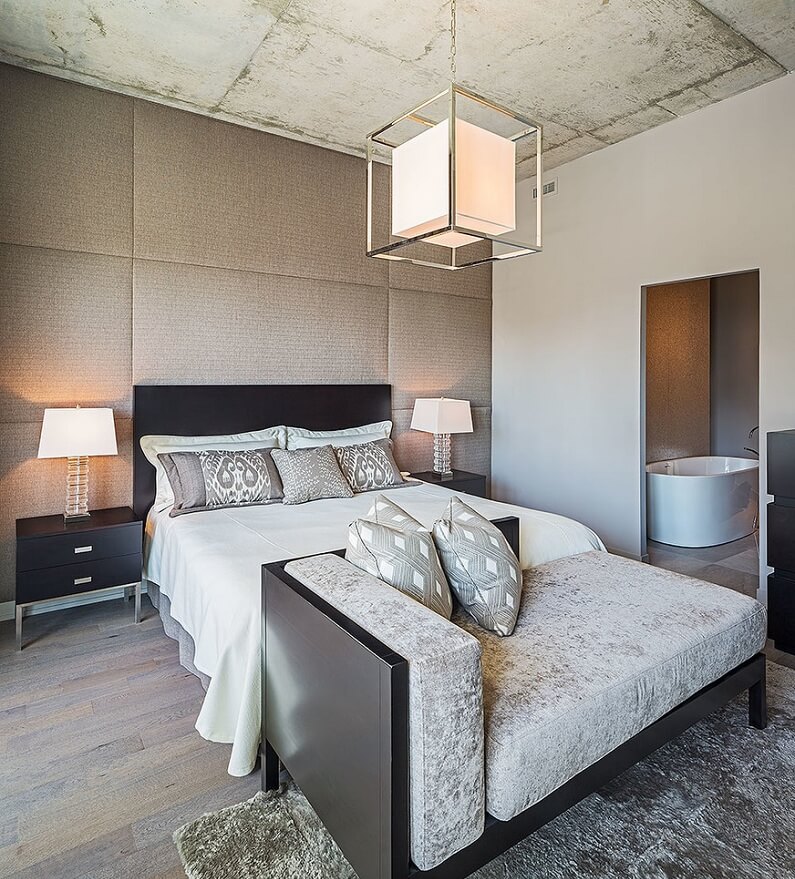
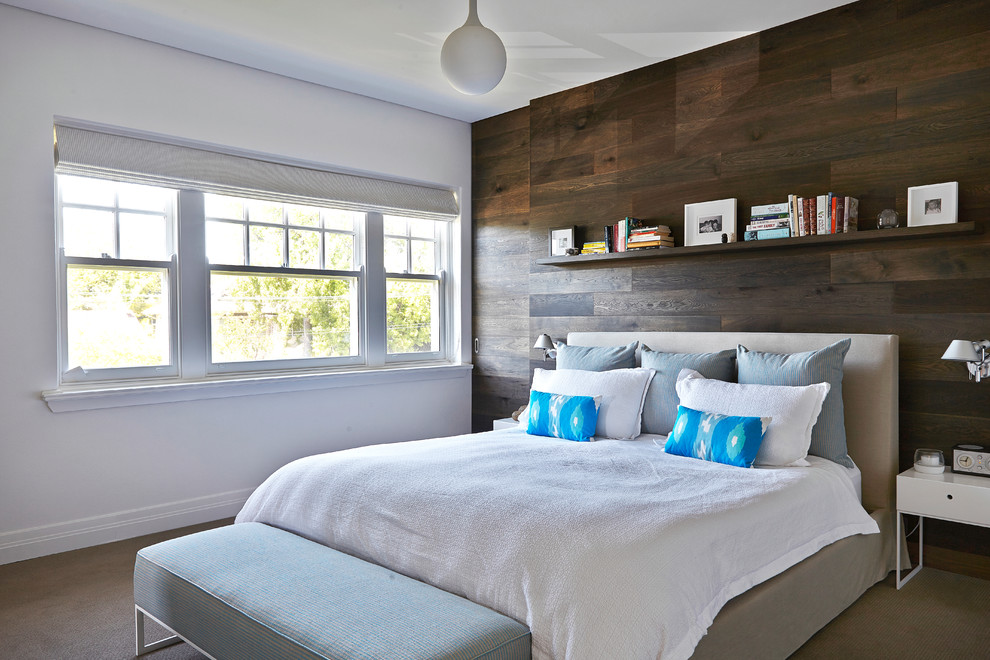 7
7
 3
3
